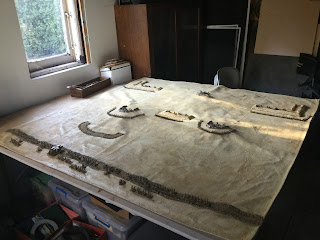Nevertheless, every project gets its moment in the sun, and 2mm ACW seems to be having just that. Besides, I want to start a Thirty Years War project in 2mm so it was time to get a wriggle on.
So, after a flurry this weekend painting is nearly complete and I am now working on basing (40x20mm). For me, one of the challenges with 2mm basing is to ensure they help show the direction the blocks are facing (very helpful with my dodgy eyesight).
When I based the Confederate force I was thinking I would need a label the rear corner for unit identification - I've since decided against that as I feel it detracts from the overall look on the table. Instead, I have decided to paint muddy ground behind the base to reflect the tramping of brogans through the pasture. I think this gives a good sense of movement for the units too.
I am working on some subtle 'landscaping' on each base with gravel, static grass and minute pieces of clump foliage. At this scale even the finest gravel looks like I'm recreating the Devil's Den! So some subtlety is required (in short supply here).
I can feel the project nearing the point where I can game with them (if I could only settle on a set of rules*!). In the meantime, I couldn't resist a quick layout for some pictures. I think the pictures show that 2mm - even with fairly rudimentary basing and paintwork can give a really good drones-eye view of civil war engagements!
*which will, of course, need to be sympathetic with my rather arbitrary decisions around basing!
I am working on some subtle 'landscaping' on each base with gravel, static grass and minute pieces of clump foliage. At this scale even the finest gravel looks like I'm recreating the Devil's Den! So some subtlety is required (in short supply here).
I can feel the project nearing the point where I can game with them (if I could only settle on a set of rules*!). In the meantime, I couldn't resist a quick layout for some pictures. I think the pictures show that 2mm - even with fairly rudimentary basing and paintwork can give a really good drones-eye view of civil war engagements!
*which will, of course, need to be sympathetic with my rather arbitrary decisions around basing!






















































